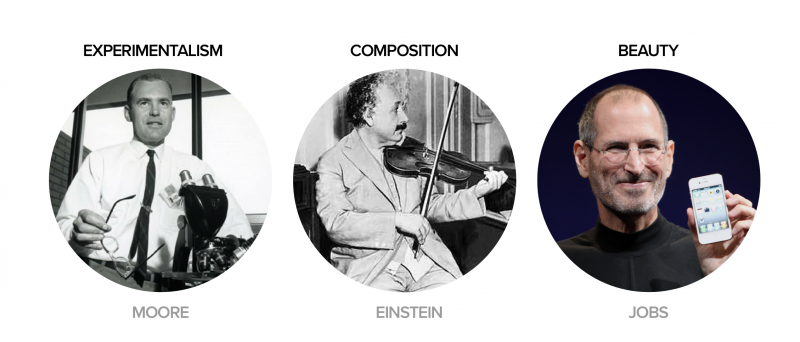Despite all the noise about “innovation initiatives,” “culture of innovation,” and “innovation roadmaps,” so many companies miss the point.

Innovation cannot be forced into the mind of employees. On the contrary, it needs to rise naturally from every person. And if you are trying to cultivate an innovative mindset in your teams, you have to understand where true innovation comes from.
Here’s the secret: it comes from the clash of two powerful forces, technology and creativity. However, you can’t just force these together, you have to grow the creative side and appreciation in your teams to truly think different.
For those skeptics out there, who immediately think that great technology has nothing to do with art, I invite you to consider three history-altering technology figures and notice the often-ignored artistic side of each one as a creative trait that enabled their genius expressions.
Gordon Moore and Experimentalism
The father of “Moore’s Law” wasn’t your average chemistry PhD – he also borrowed traits from creative artists such as the idea of Experimentalism. Artists use inspiration and impulse to express themselves, they throw caution to the wind and blindly create, consider and re-create. True artists have no fear of critical rejection in their creative mode.
Moore was a relentless experimentalist, and found most of his solutions through inspired trial and errors. Even as a kid, he experimented with the effects of explosives and almost blew his house up. Moore kept experimenting with various materials, and processes in the race to build a commercial integrated circuit.
When Moore and Noyce famously landed on a silicon base with photolithography imprinting to build the world’s first integrated circuits for mass production, it would enable the digital world that is the fabric of all our lives now (Source: Moore’s Law, Thackray, Brock, Jones). Without his willingness to keep experimenting and trying new things based on his intuitions, we may be living in an entirely different world.
Albert Einstein and Composition
Great art, be it paintings, music, stories and theater share the quality of composition. That is, many smaller elements that make up a unified larger whole. Patterns, feelings, sounds, colors, shapesand storylines come together to form a larger expression.
And it’s not accidental that the father of modern physics and the time-space dimensions, was an insane violinist. Albert could play the most complex Bach without missing a note. He even wrote:
“If I were not a physicist, I would probably be a musician. I often think in music. I live my daydreams in music. I see my life in terms of music... I get most joy in life out of music." ("Einstein and his love of music" (PDF). Physics World. January 2005.)
Did the beauty of how an orchestra works together influence his ideas of how the entire universe works? You better believe there was a strong connection there.
Steve Jobs and Visual Aesthetic
In many ways, the cover of the proverbial book does matter. How something looks sends a flood of information to our brain. The colors, shapes, textures, designs and animations of a product have incredible effect on your product users.
No one advocated this more aggressively than Steve Jobs, who thought a product “imputes” its “soul” from the moment you open the box. And that spirit continues in every touchpoint of the customer experience.
The sleek curved edges of the iPhone, the simple one-button control of the iPod, and even the Italian gray-blue Pietra Serena sandstone of every Apple Store. This focus on design and visual appeal has contributed to making Apple the most valuable company in the world (Steve Jobs, Isaacson).
Counter-Intuitive Ideas on How to Instill Innovation
Of course, we all can’t be Moores, Einsteins and Jobs. But everyone is at their core, a creative being. And in the spirit of instilling your teams with artistic inspiration, here are some concrete ideas you can try:
ART CRAWL
Plan a team trip to a series of art exhibits. Facilitate conversations about the meanings or feelings the artwork imputes, and what inspired the artist. Dance, music, visual art, movies, and alternative art can give fresh perspectives.
PAINT NIGHT
Book a Paint Night for your team, where wine, paint, and creativity flows freely.
DAY DREAM ROOM
Create a “day dream” room in the office where employees can simply relax and forget their daily logistics in favor of an inspired journey of the mind.
MINI – CONCERTS
Have employees who play music entertain others at lunch or after work. Or, hire cheap local bands to play more professional sets. An environment of music adds a creative and emotional dimension to work spaces.
Whatever way you choose, the true source of innovation is the friction between technology and art, and if you insert yourself in the middle of that friction, crazy innovation will happen.
Jeff Williams is UX Design Lead at Xinnovation.

